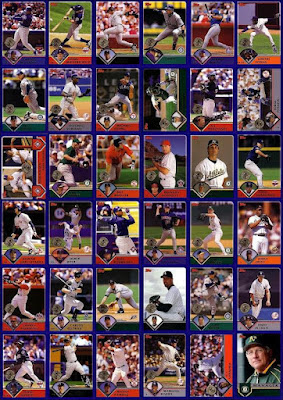The twelve teams that make up this conference were split into two divisions (click on the links to see the cards and players of each of the teams):
- Western Conference Division 1 (AL Stadiums)
- Western Conference Division 2 (NL Stadiums)
- 1990 (Chicago N)
- 1992 (San Diego)
- 1998 (Colorado)
- 2004 (Houston)
- 2007 (San Francisco)
- 2009 (St. Louis)
If you can't see the picture, here are the standings:
Western Conference Division 1
- 03 AL ALL-STAR 99-63
- 95 AL ALL-STAR 95-67
- 01 AL ALL-STAR 87-75
- 10 AL ALL-STAR 87-75
- 87 AL ALL-STAR 72-90
- 89 AL ALL-STAR 70-92
 |
| 2003 AL All-Stars - AL Western Conference Division 1 Winner |
Western Conference Division 2
- 09 AL ALL-STAR 86-76
- 98 AL ALL-STAR 85-77
- 04 AL ALL-STAR 83-79
- 07 AL ALL-STAR 80-82
- 90 AL ALL-STAR 68-94
- 92 AL ALL-STAR 60-102
 |
| 2009 AL All-Stars - AL Western Conference Division 2 Winner |
The 2001 and 2010 AL All-Star Teams shared the same 87-75 record, third best in Division 1. However, both teams split the 18 games they played against each other (with each team going 6-3 on the road). So, to determine who gets the higher seeding, the number of wins against the rest of the division were researched. After reviewing the game logs of the 144 games the two teams played against the other four teams in their division, it looks like the 2001 All-Stars went 39-33 against the rest of the division, which beats the 35-37 divisional record of the 2010 team.
Team stats:
The 1995 AL All-Stars led the AL Western Conference in batting average (.281), RBI's (900, Albert Belle with 145), OPS (.817). The 2001 AL All-Stars led in home runs (241, Mike Sweeney with 20), while the 2009 team led in stolen bases (158, Carl Crawford with 36).
The 2003 AL All-Stars won the conference regular season title with its 99-63 record. The team also led the Conference in saves with 58. The 2010 AL All-Stars team led in team ERA with a "low" 3.71. The 1987 AL All-Stars led the conference with an astounding 86 complete games while the 1995 team led in shutouts with 12 shutouts.
The 1998 AL All-Stars led the conference in fielding percentage (a low 84 errors, .986 fielding percentage).
The top four teams in each division will advance to the 32-team tournament, meaning eight teams will advance to the postseason. Each round of this postseason will consist of 10,000 simulated games, and each series will have it's own post (akin to the simulations I held on my humble, little blog). Each first place team will take on the fourth place team within its division, and each second place team will take on the third place team. So the first eight series will consist of the following teams:
Western Conference Division 1
(1) 2003 AL vs. (4) 2010 AL
(2) 1995 AL vs. (3) 2001 AL
Western Conference Division 2
(1) 2009 AL vs. (4) 2007 AL
(2) 1998 AL vs. (3) 2004 AL
Congratulations to the advancing teams. On Wednesday, the National League Eastern Conference season in review.
Sincerely,
JayBee Anama

No comments:
Post a Comment